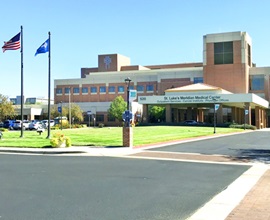Dr. Pate’s Prescription for Change
St. Luke’s finds perioperative medicine improves patient outcomes


St. Luke’s is focused on two things: improving the outcomes of care and reducing the total cost of care. One way to achieve both? Perioperative medicine. Evaluating patients before surgery has allowed us to detect conditions that would place the patient at risk for costly complications from surgery. We now have the opportunity to make interventions before surgery to reduce that risk and avoid the cost of complications. Here with more about this program is St. Luke’s Communications Coordinator Chereen Langrill.
- David C. Pate, M.D., J.D.
The foundation for a successful surgery begins long before a patient reaches the operating room.
At St. Luke’s, perioperative medicine helps build that strong foundation by helping patients better prepare for surgery.
Since its start in late 2012, St. Luke’s Perioperative Clinic has helped reduce surgical complications, last-minute cancellations and the length of patients’ hospital stays. The program is now expanding, both physically and in the role it plays in St. Luke’s quest to deliver better patient-centered care.
Perioperative medicine is a pre-emptive step for patients at higher risk for complications like infections or less-than-optimal outcomes. Such outcomes are more likely among patients with more complex, chronic medical problems like uncontrolled Type 2 diabetes or obesity, and who might also be on multiple medications.
When Dr. Elizabeth “Betsy” Olberding launched St. Luke’s first perioperative clinic in Meridian, she hoped it would lead to additional clinics. In January, an additional perioperative clinic opened at St. Luke’s Nampa under the direction of Dr. Manjusha Gupte.
Here are some of the ways perioperative medicine has transformed surgical care at St. Luke’s.
Streamlining information
Patients preparing for surgery interact with multiple caregivers, all with information and instructions relating to their procedure. When they become overwhelmed by that information, appointment times and details can be confusing. Patients might show up late for surgery or fail to properly follow instructions about when to stop drinking liquids or eating before the operation.
“They get confused having to go to multiple doctors,” Dr. Gupte said.
That confusion was also noticed by Lauren Smith, a director of clinical services for St. Luke’s Orthopedics.
Smith decided to shadow several patients through the surgery process to determine the source of their confusion, and learned that patients typically encounter more than 50 people throughout the process.
Smith connected with Dr. Olberding and the Pre-Admission Testing team, which is closely aligned with the Perioperative Clinic in Meridian, to identify gaps in communication. Patient instructions were streamlined to ensure consistency through all points of contact. In monthly lunch gatherings for patients who have had joint surgery, Smith began hearing positive feedback from patients who said they were better prepared and noticed fewer conflicting instructions.
In the operating room, the result is surgeries that stay on schedule and have fewer complications.
The common link is often perioperative medicine, because that team is the front line for patient information (establishing a medical history and identifying problems that are undiagnosed, for example) used by others on the surgical team. That patient information is vital to the surgery process, and because all participants are armed with the same information, the details are more consistent.
“The goal is that no matter who the patient calls before the surgery, they should get the same information,” Smith said.
Bridging the gap between primary care and surgery
Some people don’t have a primary care provider, or don’t see their provider on a regular basis. Perioperative medicine catches problems that people might not even know they have without the benefit of a routine medical visit.

Nearly every day, the perioperative team identifies an issue that would put a patient in danger during a surgery or diagnose a chronic condition that has gone untreated. Diabetes is a commonly seen condition, along with irregular heartbeat.
Diagnosing a condition like diabetes gives a patient the opportunity to get their condition under control prior to surgery, improving their chances for a stronger recovery.
In other cases, perioperative medicine has intercepted cases that would have been life-threatening in the operating room.
Dr. Olberding described a recent patient who served as a “classic example” of why perioperative medicine is needed. The retired man was fairly healthy and active and told the clinic he didn’t have a primary care doctor because he felt great and rarely had health problems. At Dr. Olberding’s clinic, the team discovered he had a heart murmur, and he was referred to a cardiologist. An undiagnosed heart murmur would have caused the anesthesiologist to cancel the surgery if it had been detected the day of the procedure. If it wasn’t detected, it could have caused sudden death in the operating room.
Reinforcing value-based care
Perioperative medicine underscores the benefit of value-based care by getting in front of potential pitfalls that could result in high-cost complications.
Sometimes, that means telling patients they need to delay knee replacement surgery until they lose weight, stop smoking or gain control over diabetes. It’s not what a patient wants to hear, but it is a decision that could improve the quality of a patient’s life after they leave the hospital – or even save a life.
“It’s meaning that some people aren’t getting surgery because they are too high a risk and we aren’t going to have a good outcome,” Dr. Olberding said. “We are now saying we are going to do the right thing for the patient so we can have a good outcome.”
About The Author

Chereen Langrill was formerly a communications coordinator for St. Luke’s Health System.




